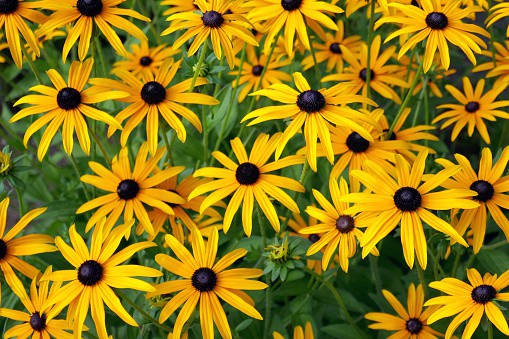Black-Eyed Susans, also known as Rudbeckia fulgida, are super floriferous and captivating plants that create a summer sun splash to any garden. Their golden-yellow, starburst-shaped blooms reach up to 2 ½ inches wide with a dark central cone and can produce up to 80 flowers per plant. Black-Eyed Susans bloom between midsummer and early fall and are very easy to grown in the full sun to partial shade.
The scientific family name of the Rudbeckia fulgida flower is Asteraceae, and it is classified as a perennial plant.
Etymology of Rudbeckia fulgida
The genus Rudbeckia is named after two Swedish botanists; Olaus and Johannes Rudbeck, who were father and son. Fulgida comes from the Latin language, meaning resplendent or lightning-like flashes. This name is derived from the striking combination of dark and golden-yellow petals of the flowers.
How to Plant and Grow
Black-Eyed Susans prefer full sun to partial shade, but they can also tolerate some light shade. When planting the flower, make sure the soil is evenly moist, evenly draining, and well-prepared. It is important to mulch the roots during the wintertime to protect the plant from extreme temperatures. They will also benefit from fertilizer twice a year.
In terms of temperature and humidity, Black-Eyed Susans like cool summers and moist air, although they can still live in areas with hot and humid weather as long as the air can circulate.
Meaning and Symbolism of Rudbeckia Fulgida
The most common symbolic meaning of Rudbeckia fulgida is its association with courage, strength, and resiliency. This is primarily due to its ability to survive and thrive in different weather conditions and various terrains. The dark and golden-yellow center of its bloom has also been said to symbolize balance in life.
History, Mythology and Religious Significance
Black-Eyed Susans have found their way into many cultures and religions over the years. In the Chinese culture, they represent luck, wealth, and courage. The Native Americans believed it to bring comfort and peace. In Christianity, it has been called the “Eyes of Jesus” and was seen to represent wisdom.
Throughout history, the Black-Eyed Susan has also been used as a simple remedy for treating skin conditions and digestive illnesses. In the world of fairy tales, the flower has been used to set the mood and capture the theme of the story.
Varieties and Their Characteristics
Rudbeckia fulgida has four main varieties:
- Rudbeckia fulgida ‘Goldsturm’: A compact mound of unusual coppery-bronze leaves which display russet and purple tones as the season progresses. The deep yellow, daisy-like flowers are further highlighted by the folding of the petals.
- Rudbeckia fulgida var. deamii: Its bicolored petals, with golden tips, are the primary attraction of this variety of Rudbeckia fulgida. This cultivar has been awarded the prestigious Award of Garden Merit by the Royal Horticultural Society.
- Rudbeckia ciliata: This is a true-blue wild flower, usually found in moist areas. Its petals have a turquoise-blue hue, while the center is made up of auburn-colored, waving stigma. It has also been documented to grow up to approximately one meter in maximum height.
- Rudbeckia hirta: A wildflower species, it is mostly grown as an ornamental in gardens and parks all over the world. The bright and cheerful yellow petals of this variety are perfect for the summer and spring months.
How to Pot and Repot
It is recommended to begin the process of potting and repotting Black-Eyed Susan in the late winter or early spring, when the plant is still dormant. If possible, use a shallow, plastic or terracotta pot containing several drainage holes. When the pot is filled with soil, place the Rudbeckia fulgida with its roots facing downwards. Make sure to provide adequate drainage by spreading rocks and gravel around the roots and leaving at least a 2-inch space between the roots and the pot.
It is also important to repot your Black-Eyed Susans every two years, or every time the leaves start to look droopy. Also, make sure to use fertilizers to ensure the growth of the plants. Lastly, don’t forget to keep the moisture and humidity levels consistent throughout the repotting.
How to Prune
Pruning Black-Eyed Susans helps to keep their shape and form, by removing unhealthy and dead stems and branches. The best time to prune is in the late winter or early spring, when the plant is still dormant. If you want to encourage more blooms, it is important to trim the spent flowers as the season progresses.
When pruning, it is important to use clean, sharp shears and pruners, and to make sure to sterilize them before and after use. Make sure to cut from ¼ to ½ inch from the stem, at a 45-degree angle. Lastly, don’t forget to check for any pests in the stems, as it could cause an infestation.
How to Propagate
Propagation of Rudbeckia fulgida can be done by division and by seed. To propagate by division, carefully dig up the whole plant and divide it into two or more pieces, each containing a healthy stem and root. Leave the divisions in a sunny and sheltered spot to allow them to produce new leaves.
Rudbeckia fulgida can also be propagated by collecting and sowing the seeds. The seeds should be sowed in a seed tray or pot, containing moist soil. Keep the soil evenly moist and place the container in a warm and sunny spot. The seeds should start to germinate about two weeks after sowing.
Common Pests and Diseases
Black-Eyed Susans are not prone to any serious pests or diseases. However, they can be prone to some fungi and virus, as well as a few insects, such as aphids, slugs, and snails. It is important to keep a watchful eye on the plants and to treat any identifying signs of pests or diseases as soon as possible, to prevent further damage.
Three Frequently Asked Questions about Rudbeckia fulgida
- What is the best way to care for Black-Eyed Susans?
The best way to care for Black-Eyed Susans is to provide consistent moisture in the soil, maintain an even temperature, and provide adequate sunlight. It is also important to check for any pest or diseases and use Fertilizers twice a year. - When is the best time to plant Black-Eyed Susans?
The best time to plant Black-Eyed Susans is in the spring, when the weather is still relatively cold. - Do Rudbeckia fulgida attract pollinators?
Yes, Rudbeckia fulgida are incredibly attractive to bees and butterflies, which have a vital role in the environment as pollinators.
Fact Sheet
| Black-Eyed Susans | Rudbeckia fulgida |
|---|---|
| Family | Asteraceae |
| Plant Type | Perennial |
| Mature Size | Up to 50cm |
| Sun Exposure | Full Sun to Partial Shade |
| Soil Type | Evenly moist, evenly draining |
| Soil pH | 7.0 |
| Bloom Time | Midsummer through to early Fall |
| Flower Color | Golden-Yellow |
| Hardiness Zones | 4 to 8 |
| Native Area | North America |
What we love from Amazon this week
Buy these wonderful flowers directly from Amazon:















